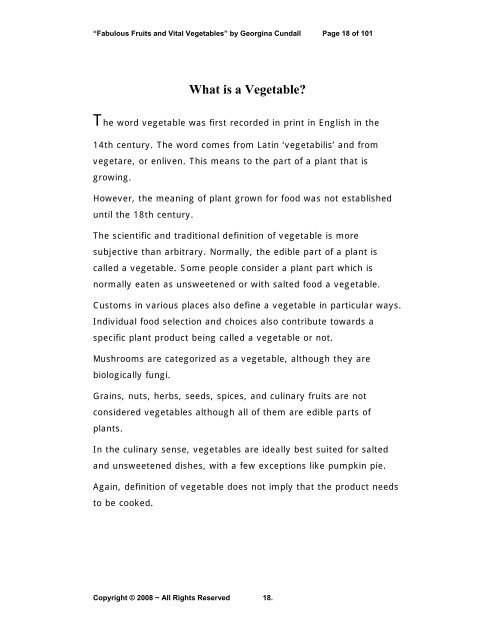Cleaning Fruits and Vegetables
Cleaning Fruits and Vegetables
Cleaning Fruits and Vegetables
Create successful ePaper yourself
Turn your PDF publications into a flip-book with our unique Google optimized e-Paper software.
“Fabulous <strong>Fruits</strong> <strong>and</strong> Vital <strong>Vegetables</strong>” by Georgina Cundall Page 18 of 101What is a Vegetable?The word vegetable was first recorded in print in English in the14th century. The word comes from Latin ‘vegetabilis’ <strong>and</strong> fromvegetare, or enliven. This means to the part of a plant that isgrowing.However, the meaning of plant grown for food was not establisheduntil the 18th century.The scientific <strong>and</strong> traditional definition of vegetable is moresubjective than arbitrary. Normally, the edible part of a plant iscalled a vegetable. Some people consider a plant part which isnormally eaten as unsweetened or with salted food a vegetable.Customs in various places also define a vegetable in particular ways.Individual food selection <strong>and</strong> choices also contribute towards aspecific plant product being called a vegetable or not.Mushrooms are categorized as a vegetable, although they arebiologically fungi.Grains, nuts, herbs, seeds, spices, <strong>and</strong> culinary fruits are notconsidered vegetables although all of them are edible parts ofplants.In the culinary sense, vegetables are ideally best suited for salted<strong>and</strong> unsweetened dishes, with a few exceptions like pumpkin pie.Again, definition of vegetable does not imply that the product needsto be cooked.Copyright © 2008 ~ All Rights Reserved 18.






